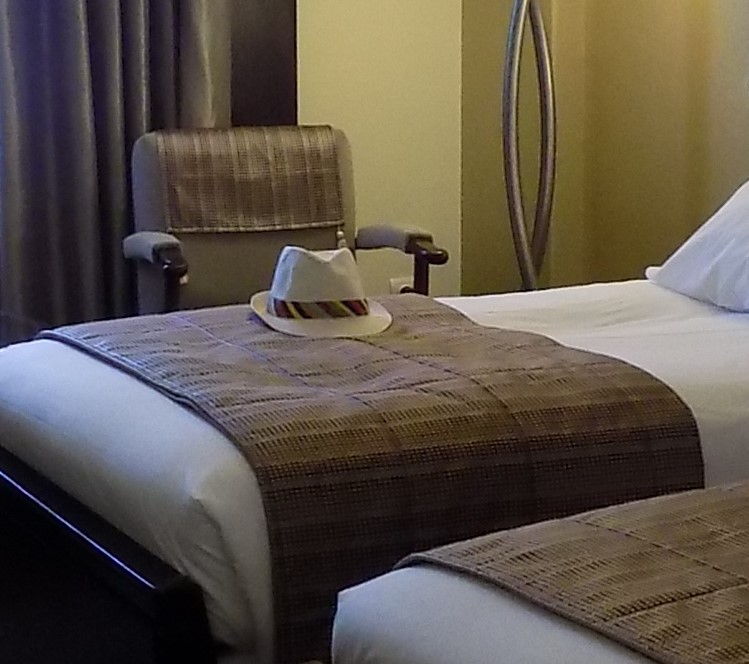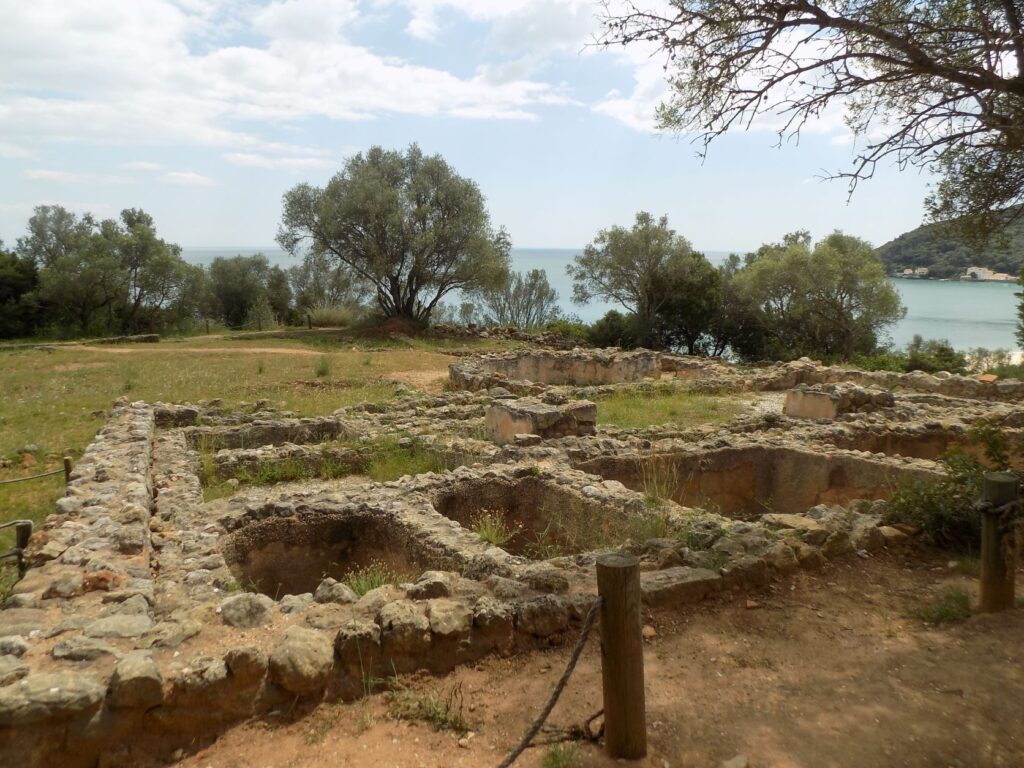Portugal, as I’ve written, isn’t a very big country. I’d checked the GPS Monday night and the drive from Tavira in the far southeast to Lisbon on the central western coast needed less than three hours. This left me plenty of time for breakfast, the opportunity to take another walk around town, and the chance to stop somewhere interesting along the way. I didn’t stray too far from the hotel in my morning walk but I did manage to acquire a new hat to add to my collection (but have since gifted to the mom of a Maryland WLAX great).

A few more driving observations.
I set out from Tavira in the later part of the morning with a plan to take a small detour and stop at Portinho da Arrábida. This spot is consistently described as one of the prettiest beaches in the country and it’s made all the more so because it lies within the Arrábida Natural Park. From there, I’d tool into Lisbon and return the rental car. While I wasn’t under any significant time pressure, I headed back to the main highways unconcerned with the tolls that the Via Verde pass would accumulate.
(Once again, I’d emphatically suggest acquiring a Via Verde pass to anyone who plans to drive in Portugal. The country now has two types of toll roads. The older toll roads have traditional pay as you go toll booths that accept cash or credit cards as well as express lanes for those with a Via Verde pass. However, beginning in 2012 on newly constructed toll roads, Portugal began using a fully electronic toll system without toll booths and that are not pay as you go.
On these roads, marked by a sign with a dark car with three circular beams expanding toward it, you pass under an array of cameras. In addition to the cameras, the highways are said to be closely monitored and tickets can be issued. You can pay the tolls after the fact at any CTT post office but you’ll need your car’s license plate and, if not paid, the toll becomes a fine in five days.)
Since these highways have tolls, they also have rest areas attached so you don’t have to exit the road. Interestingly, nearly all the rest areas have an array of of E V charging stations but none looked like they were yet in operation. I note “looked like” because I bypassed them all having pre-purchased the gas for my Toyota Corolla hybrid and thus planned to run it as low as possible before returning it. I probably lost money on the deal since the price seemed to have dropped about 10 cents per liter since the beginning of the week but the convenience outweighed the modest extra cost.
I didn’t experience any problem with tailgating drivers but I think this must be or must have been a problem in Portugal. Both the main highways I used on my way to Lisbon had stretches with arrows painted in the lanes and signs indicating that drivers should maintain a distance of at least two arrows for safety.
An unexpected treat.
After a bit under three hours on the highway, I was carefully navigating the twisty two lane road of the N379-1 to reach the Miradouro do Portinho da Arrábida for its spectacular view of the famous beach.

Since I was in the neighborhood, I thought it might also be interesting to take a look at the Creiro archaeological site about 10 kilometers up the road. But first enough of the day had gone by that a stop for lunch seemed to be in order. About halfway to Creiro I spotted a sign for a restaurant called Cevejaria Malfada. I turned down the side road, parked my car and plopped myself down at the last shaded roadside table across from the restaurant.

Two fellows sat down on the restaurant side of the road and when I heard them speaking American English, I invited them to join me in the shade. They accepted and we began talking about various subjects. They were a father and son – Clayton and Josh – from Saint Louis traveling together.
Of course when I learned where they were from, my grandfather’s raconteur gene reasserted itself and I began recounting not only my several visits to that city but also the tale of the 1904 Saint Louis Olympics, how the city had stolen it from Chicago, and some of the bizarre events including the Saint Louis Olympic marathon. Clayton was in Portugal on a business trip and since his wife couldn’t join him, he brought his college age son.
Josh expressed an interest in spending some extended time in Europe and I shared some of my experiences, talked about some of my favorite places, and gave him some tips I thought he’d find helpful – if he remembered them. They had a driver who wanted to keep to a schedule and bade me farewell as I sat at the table finishing my second beer (above). When I was done, I went into the restaurant to pay for my lunch and the server told me that Clayton had already taken care of it. This unexpected treat left me both surprised and a bit giddy.
Something fishy.
The Roman ruins at Creiro date from the first century and remained in use until the fourth or fifth century. This was an industrial site that was a fish-salting complex. Sardines and mackerel were placed in salt vats to macerate them.

The Romans likely chose the site because the process required a substantial amount of water and it was adjacent to one of the few fresh water springs in Arrábida. The entirety of the site included the factories, baths, storehouses, and a manager’s residence. I found it interesting but not fascinating enough to hold my attention for any significant time.
À la recherche du temps perdu.
I arrived in Lisbon late in the afternoon, dropped off my rental car, and walked 300 meters or so downhill to the hotel. After checking in, my first order of business was to pack up the GPS in the postage paid box, take it to the nearest CTT (Post Office), and return it to Portugal Trails. This walk was a bit longer than the one I’d just finished but still less than a kilometer along one of Lisbon’s main streets – the Avenida da Liberdade which is lined with upscale shops, restaurants, and hotels such as this converted classic movie house converted into an aparthotel.

All of my photos from the day are here.
After wandering around the immediate area and gaining a feeling of general familiarity, I wandered down a small side street near the hotel looking for a place to have dinner. I stepped into a restaurant at random and was greeted by the genial host/owner of A Sabor Lisboa who was multilingually busy speaking English to me and, as necessary, Portuguese, French, and German to other diners.
I ordered the Pastéis de Bacalhau or codfish fritters. The Portuguese eat lots of cod and prepare it in so many ways that I won’t begin to enumerate them here. The fritters on the plate looked very much like the ones in this photo from foodfromportugal
and nothing like the coddies I grew up eating in Baltimore that were served more like these from vintagerecipeblog.

But when I bit into the first fritter, for a few moments I was no longer Todd Carton but had become Charles Swann flooded with childhood memories.
At the end of the meal, I described the feeling to the owner, thanked him for it, and walked slowly back to the hotel just a block or two away. I sat quietly in my room slowly sipping a glass of port wine from the complimentary bottle provided by the hotel until I brushed away the memories and faded into sleep.